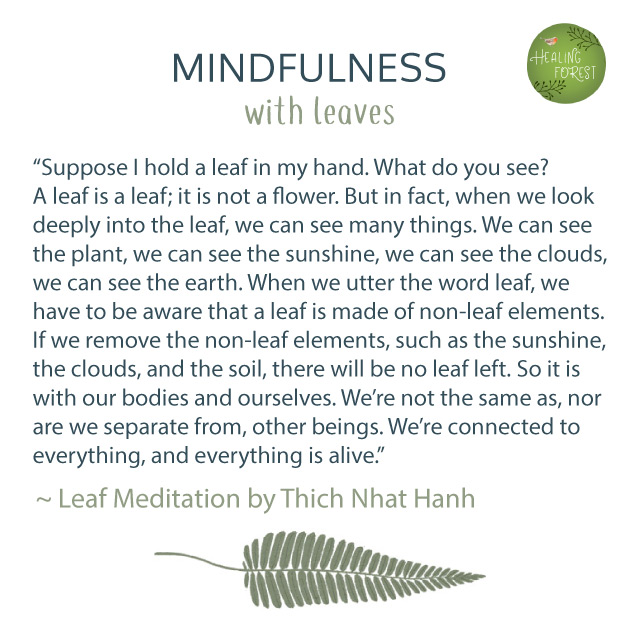Mindfulness group activities in nature offer a simple and effective way of creating enriching experiences in life. These outdoor exercises are also a great source of nurturing strong, caring groups that support each other in the time of need – just like a forest supports its individual trees.
Many people have turned to mindfulness for calm and happiness in their lives, but a large number have tried and given up too soon. While it is true that mindfulness is an individual practice, it is easier to learn, practice, and grow when you take the journey with nature and a supportive, like-minded group.

It’s because mindfulness not only allows us to create a deeper understanding of the Self, it is also about expanding the concept of Self to include others. Group mindfulness allows us to observe our mind’s struggles reflected in our peers. You learn from those who are more advanced, and you support those who are just starting.
Outdoor Mindfulness Activities for Groups
In this article we cover some outdoor mindfulness activities and exercises that are uniquely suited for groups. We’ll show you how to design the activities so that you can overcome common challenges faced while conducting mindfulness in groups. These engaging set of exercises can be adapted for people across age groups – from adults to kids. So you can practice them with friends or family.
*TIP: Mindfulness Over Zoom. As an interesting experiment, e-mail these activities to folks who may be in different cities. Ask them to do any of these nature walks at their own convenience. Schedule a mindfulness Zoom session later to share insights. It creates a beautiful experience of learning and growing with each other.

All the activities mentioned integrate elements of nature, which makes it easy for beginners to access the concept of mindfulness. The groups not only achieve the benefits of mindfulness, but also the multiple health benefits of being outdoors.
This collection is part of our Nature Calm course, covering beautiful mindfulness activities from around the world.

7. Mindful Listening: Language of the Birds
What is the difference between regular bird-watching and mindful birding? While our eyes make up the primary sense for the former, the most important sense for mindful birding is our ears. Rather than counting the number of different birds we can see, our focus is on learning how to create calm with the help of the birds.
We recommend keeping all cameras and phones away. Once you find a space that has sufficient bird activity, ask the group members to find a spot for themselves and sit in silence.
Mindfulness Group Exercise:
Listen to the closest bird.
Listen to the farthest bird.
Listen to the birds in different directions.
Listen to the silence in between the birdcalls.
Listen for conversations. Follow the sound of a particular species and imagine what the birds are trying to say?
The group can share their stories, insights and learning at the end of the session.

Spending time with the birds in a mindful way leads to some beautiful insights. Here one such story from a flock of swifts by Helen Macdonald, Author H is for Hawk.
“Swifts have, of late, become my fable of community, teaching us about how to make right decisions in the face of oncoming bad weather. They aren’t always cresting the atmospheric boundary layer at dizzying heights; most of the time they are living below it in thick and complicated air. That’s where they feed and mate and bathe and drink and are. But to find out about the important things that will affect their lives, they must go higher to survey the wider scene, and there communicate with others about the larger forces impinging on their realm.”
Just like the birds, sometimes we have to let our minds soar above our day to day worries and see our lives from a higher perspective. Mindfulness allows us to do that, helping us discover wiser choices for our future.

6. Mindful Awareness: Balance of Stones
Mindfulness creates a balance of attention and awareness. The real goal of mindfulness is not just paying attention to the mind, but creating an awareness of its true nature.
Balance exercises have found to be very helpful in relieving stress and reducing inner tension. Additionally, they improve focus, concentration and memory. Finally, the unquestionable benefit of the mindfulness activity is the ability to control emotions in critical and stressful moments. The simple act of balancing stones is a very powerful mindfulness technique.

Mindfulness Group Exercise:
The activity starts by collecting suitable stones and in the first round participants work on their own to see how high can they make their stone towers.
In the next round the same activity is done in pairs, but in silence, without any exchange of words. Once all the pairs have created their stone towers, we dismantle all the stone towers for the final round.
The final round, also done in pairs involves creating an inverted pyramid of stones – with the smaller stones at the base, and larger stones on the top.
Instead of just focusing on stacking the stones, pay attention to the center of gravity of each stone. With patience one can find out the exact alignment between two stones, which leads to the equilibrium of balance. At the end of this exercise, the group can sit in a circle and spend a little time to contemplate things that bring balance to their lives.

5. Mindful Immersion: Art of Leaves
There is a common myth that mindfulness has to be a very serious practice. However common sense tells us that to turn any activity into a habit, you have first learn how to have fun with it. If you don’t enjoy the process, it is difficult to sustain.
The mindless entertainment we engage in through television or social media may keep our attention focused, but it does not provide rest to our mind. On the contrary it over-stimulates it. One can see its impact in depleted attention spans, reduced concentration, and poor memory.
Here is a collection of 3 creative mindfulness activities that make use of the leaves for mindful immersion. These activities help you create some unique artworks, especially in Autumn.
Mindfulness Group Exercises:

Leaf Tracing: Pick any leaf. You choose a simple one or a complex shape. Trace the outline of the leaf with your eyes as slow as you can. Move from one edge of the base, all the way around to the complete the loop. This exercise is an excellent way to slow down your thoughts.

Leaf Collage: Group members work in pairs. Using different leaves they have to create a mythical or magical forest creature. Use the imagination to escape into a hidden world. This simple exercise raises the energy levels of the group. So the group leader must ensure that the silence of the group does not get lost.

Leaf Mandala: Each person in the group is assigned to collects leaves of a particular colour or shape. The group then works as one unit to create a geometric design on the forest floor using all the different leaves they have collected. It could be concentric circles, spirals, or a four-sided maze.

4. Mindful Play: Group Activities
How can we grow our mind with nature? Let us introduce you to Mindful Play, with activities that boost your attention span, observation, imagination, and emotional intelligence. These exercises are a great way for introducing mindfulness to younger audiences as well.
Just like we nourish our body with food, we can develop our mind through the play of our senses. It’s because the things we sense affect the things we think, feel, and learn. With the help of nature outside, we get a chance to understand our own inner nature and expand our mind.

One Thing: Stand in a circle. The group leader shares 1 thing in nature which is bringing them calm. All participants try and sense that 1 thing in silence for 30 seconds. Repeat the process with the next participant, until the circle is complete.
Who Am I: Participants take a short 10 minute walk in nature. Each person finds something in nature which represents them as a person. Regroup after the walk to share your object and why you chose it. This activity helps us get to know each other better and the values we hold dear. It is also a good way of seeing yourself reflected in nature.
Imagination Game: Place all the objects collected in the last round in the center of a circle. Pick up any object from the pile and ask group members to use their imagination to turn this object into something else. For e.g: A long stick can become a flying broom, or a microphone stand or a paddle for a boat. Participants have to enact the object and its use, without naming it. The others try and guess what the object is being turned into.
I Spy: As the group walks in nature, the leader finds something unique or interesting and calls out its name by saying “I spy a …(name of object – e.g mushroom / owl / blue flower). The first member in the group to spot the object, becomes the lead and gets to call out the next interesting object.
Connections: Standing in a circle, each participant chooses to be an object from nature. Moving clockwise, every member finds a partner that is related to their nature object and goes to stand next to them. For example – birds can join the trees. The clouds can join the rivers. The cycle repeats until there is only one big group left. End the activity with a group hug.
These mindfulness play activities yield insights to help us create a meaningful world. All of us are uniquely different, but we share the same home – our Earth. Expanding our mindfulness shows us that all life is deeply connected to each other. We are all part of Nature’s Play.

3. Mindful Appreciation: In Search Of Wonder
One of the most effective Mindfulness activities involves focusing on the emotion of awe, and wonder. It helps to shift our attention from the negative cycles of our mind that pull us down, to a more positive frame of mind.
For this activity we can either use the treasure-hunt model where the group goes out into nature and collects object based on a pre-given list, or we can ask the group members to just take a photograph of the objects.
For larger groups it is better to use photographs as it creates a lesser impact on the surrounding. The simple rule all participants need to follow is that you can only take one photograph per item on the list. By restricting the number of photographs, we get the group members to be more mindful of each shot they take. With this single rule we can turn our device of distraction into a mode of meditation.

Mindfulness Group Exercise:
One thing that makes you smile.
One thing that brings you calm.
One that fills you with hope.
One thing that makes you curious.
One thing that fills you with awe.
One thing that you are thankful for in nature.
What happens when we experience wonder? By Katie Steedly
People get along. When people are struck with wonder, they generally are not yelling, arguing, fighting, or angry. Wonder brings people together. We all agree that flowers are wonderful. We all agree that ducklings are wonderful. We all agree that coral reefs are wonderful. Butterflies? Wonderful. Chocolate? Wonderful. Sunsets? Wonderful. Wonder provides a moment where we can hold hands, (perhaps) tear up, and find common ground. The noise of life fades. A silence akin to speechlessness falls when we experience wonder. A gentle hush that is beyond words eases tension. Reflection paints wonderful moments with reverence. Wonder is calm in the chaos of the world.

The ability of Nature to inspire awe and wonder are one of the big factors that contribute to its healing effects on our mind. After a nature session, brain scans showed a sizable reduction of blood flow to the subgenual prefrontal cortex region. It is a region linked to sadness, withdrawal and general grumpiness.
2. Mindful Service: Gardens of Kindness
Community service as an outdoor mindfulness activity is an essential way of channelizing group energies for creating positive transformations. One such exercise involves creating or working in community gardens.

FOOD GARDEN: South Central Los Angeles, USA is a food desert – an area filled with liquor stores, fast food chains and vacant lots. Tired of driving 45 minutes to buy food that is not chemically treated, Ron Finley decided to turn some of those unused plots, starting with the patch in front of his house, into a food forest. With obesity rates 5X higher in South Central than in Beverly Hills, a neighbourhood only 8 to 10 miles away, Finley realized that food is the problem, but is also the solution. “The drive-throughs are killing more people than drive-bys”, he says. Finley and a group of volunteer gardeners from all over Los Angeles are changing that, one lot at a time. “Growing your own food is like printing your own money.”

MEDITATION GARDEN: A meditation garden is an island of tranquility which allows you to connect with nature and with yourself. It offers you a space to plant seeds of peace, hope, wonder, and joy within you. With a few simple nature elements you can transform any garden into a meditation garden. The heart of a meditation garden, beyond its visual appeal and the calming aesthetics is the thought, practice, and care which goes into connecting with your garden.
A true meditation garden is not about the space you have on ground, rather it is about creating the relation between your mind and your garden.

You can also learn how to create your own meditation garden through this article.
The real measure of our progress in mindfulness reflects in our behaviour and actions. The awareness of mindful groups is not limited to the present moment, but extends to foresee the impact of their actions on the future. We hope these example will inspire you to to create your own mindfulness community garden program.

Mindfulness of Breath
Every breath we take is a gift from nature. By being mindful of this simple truth we can learn a beautiful life-lesson. Watch this forest song to practise the mindfulness activity hidden in every breath. *Sound on, and full-screen recommended.
“Nothing ever exists entirely alone. Everything is in relation to everything else.”
~Buddha

Take a deeper dive with the Japanese art of nature mindfulness.
150+ mindful activities for your mind, body, relationships >> Nature Calm
We hope you enjoyed these outdoor mindfulness activities for groups. Add your own mindfulness exercises in the comments below to grow the collective knowledge.
To get amazing new ideas once a month, join our free newsletter.
Mindfulness Activities For Groups: Summary
In nature everything exists as a relationship. Through mindfulness we learn to explore of our relationships with self, others and nature. Seeing a part of our Self in everything, and a part of everything in our Self, is the essence of mindfulness that groups help us discover.

Healing Forest is a project that aims to bring people and forests closer to each other through creativity and mindfulness. Our goal is simple. Helping people heal. Helping forest heal.
REQUEST: Please share this post so that it reaches those who might find it helpful.




nice article. this article is helpful for me
LikeLike
I just love your ideas
LikeLike